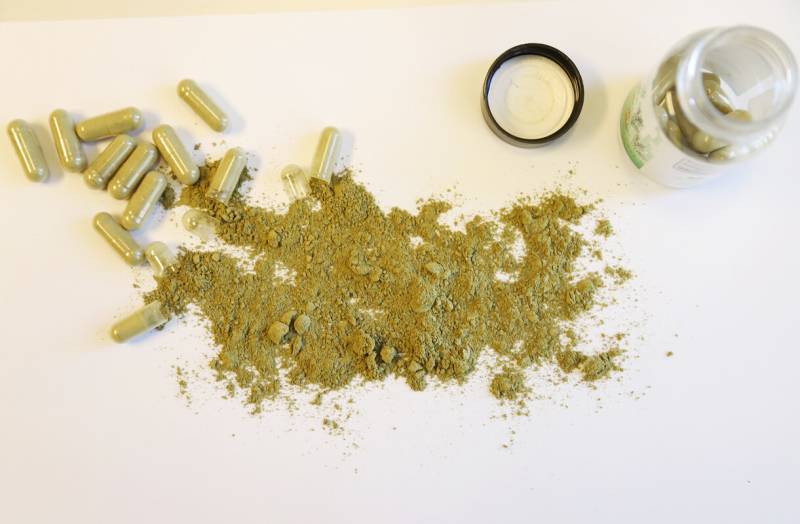“Right now, there are no rules on kratom at all,” said Assemblymember Matt Haney (D-San Francisco), the sponsor of a new bill that would set the strongest restrictions on kratom in the country. “You can sell it at any store. You don’t have to label it. It is the Wild West. And that is dangerous for Californians.”
Kratom is derived from the leaf of a tree common in tropical regions of Southeast Asia. It can be chewed, brewed, and crushed into dusty green powder. In the U.S., it is sold as a pill, capsule, or extract. Companies claim it can relieve pain, depression, and anxiety. Research shows a small dose can give you a boost of energy, while a large one can put you to sleep.
After two years of consistent use, Telman started to feel tired all the time, and his heart “felt weird, like it wasn’t beating right,” which is a concern backed by evidence that includes incidents of cardiac arrest. Heart disease is rampant in Telman’s family, and he said a voice in his head nagged, “Tick tock, Nick.”
He enrolled in a recovery program, but “quitting was a nightmare.” Withdrawal symptoms can include cold sweats, insomnia, pain, fever, diarrhea, tension and anger. “I wanted to die for like five days,” Telman said.
Proposed regulation
A proposed measure would require manufacturers to register kratom products with the state, provide labels with recommended doses, warn consumers that addiction is possible, and restrict sales to anyone under 21. Plus, it would limit the amount of 7-Hydroxymitragynine, which is one the more potent alkaloids in kratom that researchers suggest can potentially lead to worse outcomes.
“We urgently need to limit the type of products that can be sold and make sure that people know what they’re getting,” Haney said.
The Assembly passed the measure, and it is currently before the state Senate.
The Food and Drug Administration and Drug Enforcement Administration warn that kratom can lead to physical and psychological dependency. The FDA advises against its use, and the DEA nearly banned it in 2016 before advocates and politicians pushed back and the agency halted those plans. Nowadays, kratom sits on the DEA’s “drugs of concern” list.
Some industry groups are calling on officials to rein in unscrupulous players.
“The proposed California bill allows consumers to walk into the kratom journey with their eyes wide open, and they know exactly what it is that they’re doing,” said Matthew Lowe, executive director of the Global Kratom Coalition. “The measure walks a thin line between allowing access and appropriately regulating a substance that the FDA is not currently regulating.”
The American Kratom Association also supports more oversight but calls the California measure an overreach. “The bill is well-intentioned,” said Mac Haddow, the advocacy organization’s senior fellow on public policy. “But it goes too far.”
He said the proposal would be expensive to implement and would “bar many creative manufacturers” from entering the market. He would rather see California implement the “Kratom Consumer Protection Act,” a model adopted in 13 other states that asks manufacturers to ensure safety without state oversight.
‘It gave me my soul back’
Twelve years ago, Jordan Richard was living in roach-infested hotels. In a single week, the 19-year-old overdosed on heroin twice.
“I remember hearing my mom cry in the hospital. I was like, ‘Oh my, I have to make a change,’” he said.
When he returned home, he started researching natural ways to wean off opioids. He followed a Craigslist advertisement from a guy selling loose kratom powder in the San Bernardino mountains.
“When I took it, I felt like I was myself again,” he said. “It’s like the kratom put a pause on my brain to help me look at what I was doing with my life. I have never touched a hard drug since.”
Now, he drinks kratom with water morning, noon and night. He calls it his antidepressant and credits the herbal brew for giving him his “soul back.” Today, Richard is married, has five children, and runs New Hope Botanicals — a kratom shop in Crestline, a community located in San Bernardino County.
Dr. Scott Steiger, deputy medical director of the opiate treatment outpatient program at Zuckerberg San Francisco General Hospital, said he cautions patients with opioid use disorder who ask about kratom.
“I have seen that people who use kratom end up having a very hard time stopping the use of it,” Steiger said.
Doctors have evidence-based treatments like buprenorphine and methadone to help people with an opioid addiction. He doesn’t recommend self-medicating with kratom until more research is available.
The FDA has recalled dozens of salmonella-tainted kratom products and found toxic heavy metals like nickel and lead in some supplements. The Centers for Disease Control and Prevention reported 90 kratom overdoses over 18 months, often involving other ingredients that companies may mix into their products, like antidepressants.
‘He was the love of my life’
J.D. Butler was one of them. The 27-year-old kindergarten teacher had a grand mal seizure while dining at the Mermaid Inn Restaurant in New York City on April 13, 2019. He and his girlfriend at the time, Alley Parsons, were celebrating their first anniversary.
“In the ambulance, I noticed his hand just flopped, and the EMT started freaking out,” Parsons said.

